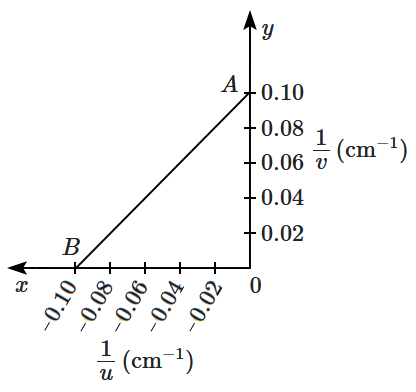Select Question Set:
To increase the angular magnification of a simple microscope, one should increase:
| 1. | the focal length of the lens | 2. | the power of the lens |
| 3. | the aperture of the lens | 4. | the object size |
Subtopic: Simple & Compound Microscope |
60%
Level 2: 60%+
Hints
Given below are two statements:
| Assertion (A): | If objective and eye lenses of a microscope are interchanged, then it can work as telescope. |
| Reason (R): | The objective lens of telescope has small focal length. |
| 1. | Both (A) and (R) are True and (R) is the correct explanation of (A). |
| 2. | Both (A) and (R) are True but (R) is not the correct explanation of (A). |
| 3. | (A) is True but (R) is False. |
| 4. | Both (A) and (R) are False. |
Subtopic: Telescope |
Level 4: Below 35%
Please attempt this question first.
Hints
Please attempt this question first.
The image formed by a concave mirror:
| 1. | is always real |
| 2. | is always virtual |
| 3. | is certainly real if the object is virtual |
| 4. | is certainly virtual if the object is real |
Subtopic: Reflection at Spherical Surface |
54%
Level 3: 35%-60%
Hints
The power of a lens (biconvex) is \(1.25~\text{m}^{-1}\) in a particular medium. The refractive index of the lens is \(1.5\) and the radii of curvature are \(20\) cm and \(40\) cm respectively. The refractive index of the surrounding medium is:
| 1. | \(1\) | 2. | \(\dfrac 97\) |
| 3. | \(\dfrac 3 2\) | 4. | \(\dfrac 4 3\) |
Subtopic: Lens Makers' Formula |
55%
Level 3: 35%-60%
Please attempt this question first.
Hints
Please attempt this question first.
A ray of light is directed toward a corner reflector as shown. The incident ray makes an angle of \(22^\circ\)
| 1. | \(22^\circ\) | 2. | \(68^\circ\) |
| 3. | \(44^\circ\) | 4. | \(34^\circ\) |
Subtopic: Reflection at Plane Surface |
80%
Level 1: 80%+
Please attempt this question first.
Hints
Please attempt this question first.
An object and a plane mirror are shown in the figure. The mirror is moving with velocity \(V\) as shown. The velocity of the image is:
1. \(2Vsin\theta\)
2. \(2V\)
3. \(2Vcos\theta\)
4. none of these
Subtopic: Reflection at Plane Surface |
61%
Level 2: 60%+
Please attempt this question first.
Hints
Please attempt this question first.
As light traverses through an optical medium, it is observed that its wavelength decreases.
| Statement I: | In this case, the frequency of light increases. |
| Statement II: | In the above case, the refractive index of the medium increases. |
| 1. | Statement I is incorrect and Statement II is correct. |
| 2. | Both Statement I and Statement II are correct. |
| 3. | Both Statement I and Statement II are incorrect. |
| 4. | Statement I is correct and Statement II is incorrect. |
Subtopic: Refraction at Plane Surface |
65%
Level 2: 60%+
Hints
In the figure, a ray of light is perpendicular to face \(\mathrm {AB}\) of a glass prism \((\mu=3/2)\). If prism is immersed in water \((\mu=4/3),\) what will be the maximum value of \(\theta\) so that ray suffers total internal reflection at face \(\mathrm{AC}\)?
(Take \(\text{sin}^{-1}(8/9)=63^\circ\))

1. \(15^\circ\)
2. \(27^\circ\)
3. \(37^\circ\)
4. \(45^\circ\)
(Take \(\text{sin}^{-1}(8/9)=63^\circ\))

1. \(15^\circ\)
2. \(27^\circ\)
3. \(37^\circ\)
4. \(45^\circ\)
Subtopic: Total Internal Reflection |
76%
Level 2: 60%+
Please attempt this question first.
Hints
Please attempt this question first.
A magician during a show makes a glass lens with \(n=1.47\) disappear in a trough of liquid. What is the refractive index of the liquid?
1. \( 1.47 \)
2. \( 1.33 \)
3. \(0.66 \)
4. \( 1.5\)
Subtopic: Refraction at Curved Surface |
80%
Level 1: 80%+
Hints
Links
The graph between \(\dfrac1u\) and \(\dfrac1v\) for a thin convex lens in order to determine its focal length is plotted as shown in the figure. The refractive index of the lens is \(1.5\) and both surfaces have the same radius of curvature \(R.\) The value of \(R\) is: (where \(u\) \(=\) object distance, \(v\) \(=\) image distance)


| 1. | \(10~\text{cm}\) | 2. | \(20~\text{cm}\) |
| 3. | \(30~\text{cm}\) | 4. | \(40~\text{cm}\) |
Subtopic: Lens Makers' Formula |
66%
Level 2: 60%+
Please attempt this question first.
Hints
Please attempt this question first.
Select Question Set:








